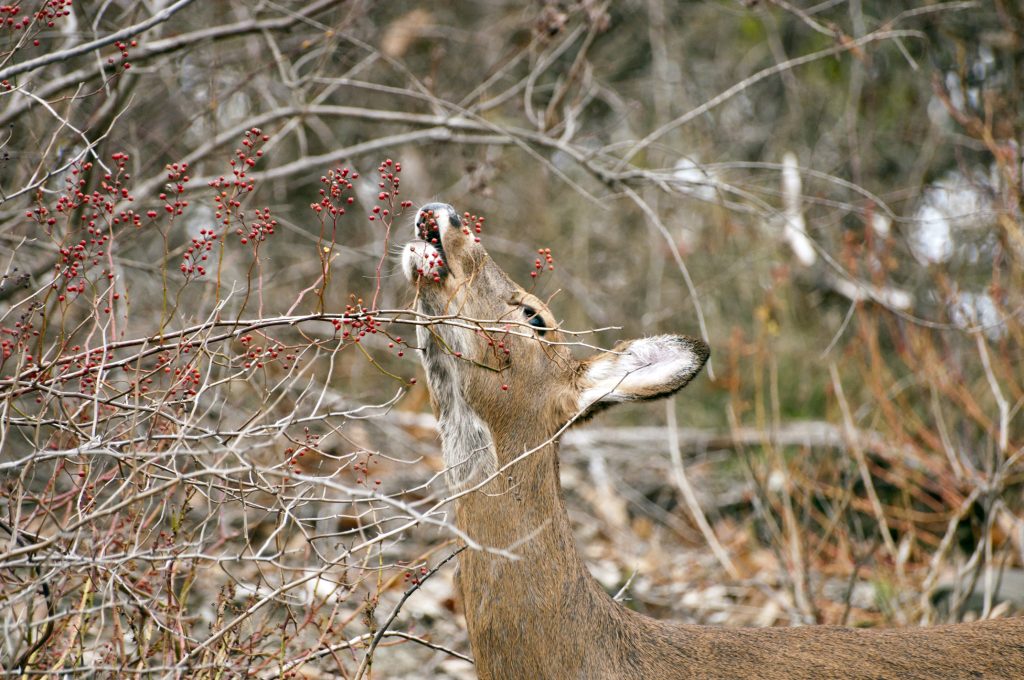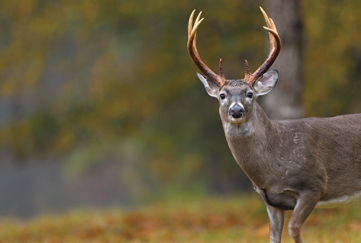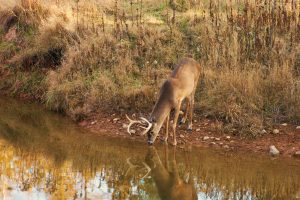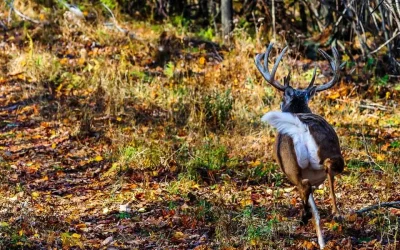Other than the rut, deer really don’t wander around that often. However, the daily routes they use will not be static because food sources and conditions are constantly changing. Each plant has a peak period of abundance, taste appeal, and nutritional value. Deer know this intuitively and will vary their travel routes according to which food is most helpful for their survival and most palatable from week to week.
The more you are aware of the general bedding areas of the local bucks, and where and when various food sources are at maximum production and palatability, the more likely you are to enjoy success when the rut is NOT on. Hunt the “food of the day,” or along a route deer use to get there. Following are nine such stand sites.
Deer Stands Near Brassica Plot After a Cold Snap
Foods such as radishes, rape, turnips, and kale can draw deer at any time. But they are especially appealing after a cold front blows in. Temperature drops increase the animals need for energy and heat, two things these plants provide. In addition, the plants are at their peak palatability timeframe, making them especially sweet and attractive.
Use trail cameras or scout ahead of time with optics to see what specific plots mature bucks are hitting and which parts of the plot they are using with different wind conditions. Find a good tree just off the plot, downwind, preferably slightly back from the edge, but with good visibility of where the deer enter and do most of their feeding. Often the best winds will be from the north or northwest, since they often bring cold weather that increases buck movement.
During summer clover and alfalfa fields sometimes suffer from high temperatures and drought. As fall’s cool air and rains arrive, they begin to perk up. And these fields become even more attractive a week or two after they’ve been mowed or hayed. The plants grow back new shoots quickly. That forage is more tender and palatable with higher protein and nutritional content.
Keep track of local alfalfa fields and see which ones look ripe for haying. Check with farmers and landowners to see when they are going to cut. If you plant your own clover or alfalfa, plan your hunt for each field based on the mowing schedule. You can even stagger your cutting dates in different fields so you can switch from one recently-mowed location to another.
Thinly-outlined Trail in Woods Paralleling Major Trail (“Shadow Trails”)
Before the rut kicks in, mature bucks and does are pretty much segregated. Older bucks have holed up mostly alone during summer or maybe hung out with a few fellow senior citizens. Odds are, however, they’ll be heading to the same evening feed areas as the does and young bucks. That sees them traveling routes through a bit thicker cover or more arduous terrain than the ladies, but paralleling the trails those deer are taking.
To find these spots, first locate the major doe trails heading from bedding cover to feed areas, which stand out and are usually easy to find. Then do your detective work to pinpoint lighter, more thinly trodden paths 20 to 80 yards to the side of those well-worn trails (frequently on the prevailing downwind side), often in areas with more cover and steeper terrain, with harder walking.
Such “shadow” trails accomplish two things for mature bucks. They get them to the evening feed area and they let them keep an eye on the ladies to monitor the first ones that might be coming into rut. While they aren’t ready to breed them yet, they want to be first on the scene when one goes into estrous. Find large fresh tracks to confirm they are being used and maybe a stray rub or two, or monitor suspected shadow trails with cameras. Hang your stand downwind of that skinny trail where prevailing air currents won’t bust you.
Deer Stand Near The Right Water Hole
While food is their major need, deer also require several quarts of water a day. During spring, they may not need to visit water sources as often because there is so much moisture in the forage that they’re eating. However, closer to and during the hunting season that is not the case. They may get it on their way to evening feed areas or on a separate trip during midday if it’s particularly hot and dry. Spring seeps, small ponds, ditches that collect water are all potential stand sites if trail cameras or sign show they’re being used. For an older buck to visit a water source during shooting light, there needs to be security cover along his approach route and near the pond itself.
Often the best water holes are ones you create. That way you can put them exactly where you want them in relation to prevailing winds and the cover situation. A kid’s pool, livestock tanks, pond liner material, or special deer watering systems all work. Alternately you can dam up small wet-weather streams with sticks and rocks.
To make the pond appealing, plant cover such as conifers or fast-growing shrubs along the approach route or at the pond itself if needed. Tall annual grasses such as Blind Spot, Egyptian wheat and Sudan sorghum, or native warm season grasses like switchgrass are also good.
Hang a stand at the water hole if wind and cover offer a good ambush spot. If not, follow the approaching tracks back far enough to find the perfect downwind tree along the buck’s travel route.
Stands Near Dropping Acorns
When hunters complain about the “October lull” the truth is deer have probably just switched their food source from fields and plots to hard mast in the woods. No matter how many times you’ve watched deer in alfalfa or clover fields during August, once the acorns drop, they’ll often abandon the legumes and move to that food source. They need the fat, carbohydrate source and energy to help them survive winter.
The key to finding the best hard mast stand is to locate an area that has a particularly large amount of acorns, especially the sweeter white oaks that have less tannins. Look for large hoof prints, scuffed leaves, scattered rubs and a good tree where you’ll be undetected.
Find the trees that drop their mast earliest and focus on those first. Also keep notes on which trees drop the most nuts and what date they start. They’ll usually be the best early producers next year at the same time. The optimum situation for hunting is when the mast crop is fairly spotty. That concentrates deer in those areas that do have nuts.
Staging areas near the edge of evening feeding sites are areas where bucks and does gather before entering the more exposed open areas with the best food as darkness falls. But the wariest mature bucks often hang back in the woods even farther.
Backtrack from those major staging areas towards thicker or more elevated bedding cover and find benches, dips, points, or knolls with a bit more cover than the surrounding woods. That’s where you’ll pinpoint “micro staging areas” where the largest animals hold up until later in the day. A blowdown, briar patch, or a few shrubs is all that may be needed for mature deer to hang up here for a while before heading to the major staging area, often not arriving there until near dark.
A few big rubs, large tracks, beds, and nibbled-on browse will help you pinpoint them. Older bucks will mill around for a short period in these spots before joining the rest of the at the main staging area later or going straight to the open fields at even bed down these spots for a short while.
Be sure to arrive at these sites early. Since they’re situated closer to bedding cover, deer may show up here a full hour or more before shooting light ends, intending to loaf around and nibble secondary foods or simply wait for darkness to start to fall.
Deer Stand Locations Near Soft Mast Clusters

(Photo By T.M. McCarthy)
While many shrubs deer like to feed on during summer dry out by fall, brambles such as blackberry, raspberry, grape vines and honeysuckle remain attractive to deer well into fall. They ate the fruits in summer. Now they’re switching to the leaves and tenderest parts of the stems. They particularly like the new lighter green leaves that re-sprout after they’ve consumed the larger ones, similar to the animals’ preference for re-growing clover and alfalfa after those plants have been cut. They also like the thickets of cover that large stands of these plants offer.
These plants are most common along field and forest borders, fence lines, cleared areas in woods, brushy edges, and logging roads. That sometimes makes trees for stands scarce. Solve that by setting up a ground blind or tower stand.
To help concentrate deer activity, select patches of these shrubs near your chosen ambush site before the season and fertilize them with 10-10-10 or similar. Also toss on a few buckets of pelletized lime. That will enhance the protein, tonnage, and palatability of those plants near your stand compared to surrounding ones and entice bucks into range for a shot. These shrubs can also be purchased and planted at prime destinations for a stand site.






0 Comments